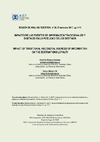Please use this identifier to cite or link to this item:
https://accedacris.ulpgc.es/jspui/handle/10553/70866
| Title: | Impacto de las fuentes de información tradicionales y digitales en la fidelidad de los destinos | Other Titles: | Impact of traditional and digital sources of information on the destinations loyalty | Authors: | Almeida Santana, Arminda Moreno Gil, Sergio |
UNESCO Clasification: | 531290 Economía sectorial: turismo | Keywords: | Fidelidad Horizontal Marketing Relacional Fuentes de Información Redes Sociales Imagen, et al |
Issue Date: | 2017 | Journal: | Revista de análisis turístico | Abstract: | Numerosos estudios han demostrado que las redes sociales influyen en las intenciones de los viajeros de visitar un destino. Sin embargo, la literatura ha prestado poca atención a la relación entre el comportamiento de búsqueda de información y el desarrollo de la fidelidad a los destinos. En este sentido, este estudio analiza este fenómeno, considerando cómo los turistas no sólo comparten su tiempo entre varias fuentes de información, sino que éstas están también influyendo en el tiempo que los turistas están compartiendo entre varios destinos, no sólo repitiendo la visita a un único destino, sino también haciéndose más fieles a múltiples destinos al mismo tiempo (fidelidad horizontal). Sin embargo, este tema no se ha destacado adecuadamente en el contexto turístico. Por lo tanto, el objetivo de este estudio es doble: 1) comprender mejor el comportamiento del turista con respecto al uso de las redes sociales, considerando las diferencias por nacionalidades, género y edad; y 2) explorar la relación entre el uso de las diferentes fuentes de información de los turistas (tradicionales y digitales) y su influencia en la posterior fidelidad (tanto a un solo destino como en la fidelidad horizontal), y considerando tanto la fidelidad conductual como la actitudinal. Estos resultados son útiles para tomar decisiones sobre estrategias de comunicación digital y la gestión de los programas de fidelización por parte de los destinos turísticos. The visit to a tourist destination is influenced by the tourist's use of social media. However, the literature has not focused its efforts on trying to understand the relationship between the use of social media and destinations loyalty. This study analyzes this phenomenon, considering how tourists not only share their time between several sources of information, but these are also influencing the time that the tourists are sharing between several destinations, not only repeating the visit to a single destination, but also becoming more loyal to multiple destinations at the same time (horizontal loyalty). However, this topic has not been adequately highlighted in the tourism context. This study tries to analyze the differences in the use of social media by nationalities, gender, age and income; and to shed light on their relationship with loyalty. These results are useful for making decisions about digital communication strategies and the management of loyalty programs by tourist destinations. |
URI: | https://accedacris.ulpgc.es/handle/10553/70866 | ISSN: | 2254-0644 | Source: | Revista de análisis turístico [ISSN 2254-0644], n. 24, p. 1-11 |
| Appears in Collections: | Artículos |
Page view(s)
614
checked on Sep 30, 2023
Download(s)
284
checked on Sep 30, 2023
Google ScholarTM
Check
Share
Export metadata
Items in accedaCRIS are protected by copyright, with all rights reserved, unless otherwise indicated.
